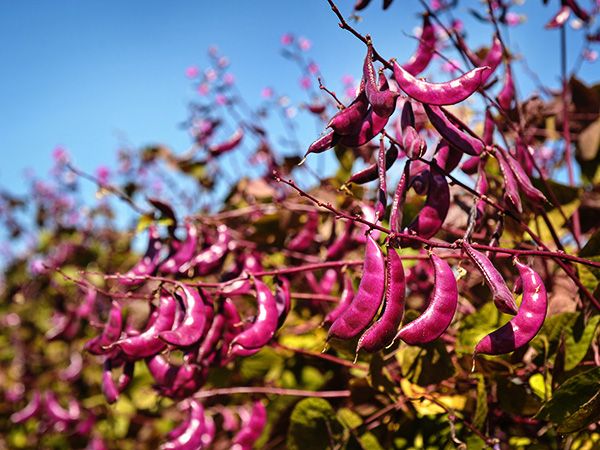The information on this page applies to seedlings sold by LEAF Nursery during our 2021 Seedling Sale.

*Toxic Warning*
Lablab purpureus Beautiful purple pods are used in Asia as a curry and stir-fry vegetable. Pick when small and tender, as old pods and dry beans may be poisonous! The long, rambling vine is also very ornamental, with lilac-colored blossoms and purple stems. Thomas Jefferson planted this fine bean at Monticello. Contains toxins; not recommended for eating. [1] Mature seeds must be boiled before eating. Like most soybeans, they contain a trypsin inhibitor that is broken down by heat as well as a cyanogenic glucoside that is leached out by the cooking water.[2]
Seed Type
| Organic | Heirloom | Non-GMO | Hybrid | Open-pollinated | Untreated |
Additional Information
| Container Friendly | Trellis Needed | Easy to Grow | Pollinator Friendly |
When to Plant Your Seedling
| Jan | Feb | Mar | Apr | May | Jun | Jul | Aug | Sep | Oct | Nov | Dec |
Growing Conditions
| Light | Temperature | Soil | Water |
|---|---|---|---|
| Full Sun to part shade | 70-85 F Soil temp | The soil needs to be rich in organic matter, well drained, loose, and warm | Evenly moist but not soggy. Water soil not foliate to reduce chance of fungal disease |
Planting Tips
| Plant Spacing | Plant Size | Days to Maturity |
|---|---|---|
| 12" | 10-20' |
- Additional instructions: Loose clusters of 1" purple sweet-pea-shaped flowers followed by attractive, shiny, 3"–5" long purple pods. Drought tolerant. Roots are sensitive to disturbance; use biodegradable pots that can be placed directly into the ground or be very careful when transplanting. Provides colour all season. Blooms and pods are useful as cut flowers; pods may be dried. Also known as bonavist-bean, and lablab-bean. Tender perennial in Zones 9–10. Best grown as an annual elsewhere.[1]
- Annual vine for covering walls, trellises or fences. Good annual privacy vine for porches. Effective ground cover. Containers. Vegetable gardens.[3]
- Harvesting instructions: Edible Flowers: Flowers can be eaten raw or steamed, and can be used as a garnish for salads and desserts. Flavor is mild, bean-like, and sweet.[2]
- Purple stems, lilac-rose blossoms, and shiny 2–3" magenta pods. While all parts of the plant are edible, we recommend boiling the mature seeds twice (discarding old water and starting with new) before eating. Used in Asian, Thai, and Indian cuisine.
Common Diseases and Pests
- No serious insect or disease problems though it is much beloved by Japanese beetles, which can make the leaves resemble Swiss cheese. Vines survive, however, and produce handsome new foliage for late season enjoyment.[3]
Useful Resources
- https://www.rareseeds.com/store/vegetables/hyacinth-bean-moonshadow(Seed Source)
- https://www.johnnyseeds.com/flowers/hyacinth-bean/ruby-moon-hyacinth-bean-seed-1002.html
- http://www.missouribotanicalgarden.org/PlantFinder/PlantFinderDetails.aspx?kempercode=a114
- https://plants.usda.gov/plantguide/pdf/pg_lapu6.pdf
- https://sfbaygardening.com/resources/bay-area-planting-calendar/
If you bought this seedling and have any questions or feedback, let us know in the comment section below.